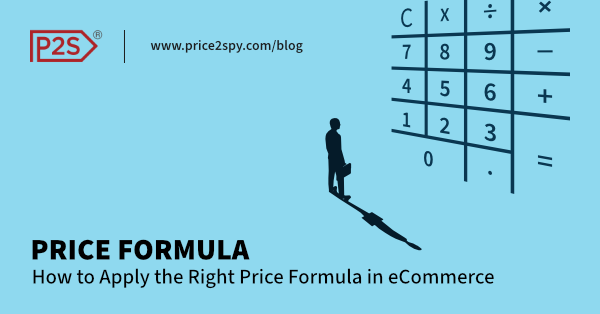
How to Apply the Right Price Formula in Your eCommerce Business
In eCommerce, the right price can make the difference between steady growth and declining margins. While intuition and market feel have their place, successful online retailers rely on clear, repeatable methods to set prices. This is where a price formula comes in.

Think of formulas as frameworks that ensure every selling price covers costs, aligns with market expectations, and supports business goals. It is a difficult task to achieve all of that. In an online environment where thousands of products and constant price fluctuations are the norm, this is even more difficult.
What Is a Price Formula?
A price formula is a calculation method used to determine the selling price of a product. At its simplest, it can be expressed as:
Selling Price = Cost Price + Markup
In eCommerce, however, the formula often goes beyond cost and markup. Online retailers must account for additional factors such as shipping, platform fees, payment processing costs, and marketing spend.
For example, an Amazon seller’s price formula might include:
Selling Price = Product Cost + Shipping + Marketplace Fees + Marketing Costs + Desired Profit Margin
The aim is to ensure that every product sold not only covers all expenses but also generates the intended profit. A good price formula should be flexible enough to adjust to changes in costs, demand, or competition while remaining simple enough to apply across a wide product catalog.
Why Price Formulas Matter in eCommerce?
Price formulas help eCommerce businesses operate efficiently in a fast-moving market. They:
- Protect margins by ensuring all costs are covered.
- Enable scalability when pricing hundreds or thousands of SKUs.
- Support automation by allowing pricing tools to adjust prices in bulk.
- Maintain consistency across different sales channels and regions.
Without a clear formula, pricing decisions can become inconsistent, reactive, and vulnerable to margin erosion. For online retailers, a well-defined price formula is a safeguard against underpricing while also serving as a baseline for competitive and promotional strategies.
Common Price Formulas in eCommerce
Cost-plus pricing
Formula: Selling Price = Cost Price + Markup Percentage
Example: If a product costs $20 and you apply a 40% markup, the selling price is $28.
Pros: Simple, ensures cost coverage.
Cons: Ignores customer perception and competitor prices, which can lead to missed opportunities or overpriced items.
Keystone pricing
Formula: Selling Price = Wholesale Price × 2
Traditionally used in retail, keystone pricing doubles the wholesale cost to arrive at the selling price.
Pros: Easy to calculate and standardize.
Cons: Not always competitive in eCommerce, especially in categories with aggressive discounting.
Competitive pricing
Formula: Selling Price = Competitor Average ± Adjustment Factor
This approach sets your price in line with or slightly above/below your main competitors.
Pros: Keeps you competitive in price-sensitive markets like electronics or commodity goods.
Cons: Can trigger a race to the bottom if competitors are underpricing. Works best when combined with clear differentiation.
Value-based pricing
Formula: Selling Price = Customer Perceived Value – Discounts or Incentives
Instead of focusing on cost, this method sets prices based on the value customers assign to a product.
Pros: Maximizes profit potential for unique or branded items.
Cons: Requires strong understanding of customer psychology and brand positioning. Not ideal for commodity products.
Dynamic pricing
Formula: Selling Price = Base Price × Demand/Market Adjustment Factor
In this model, prices adjust in real-time based on demand, inventory, competitor prices, and other variables.
Pros: Optimizes revenue in fast-moving markets.
Cons: Requires automation and careful monitoring to avoid alienating customers.
Note about pricing formulas
A successful eCommerce business often uses a hybrid approach, applying different formulas to different product categories or sales channels. For example, value-based pricing might work best for a premium private-label product, while competitive pricing might be better suited for commodity items sold on marketplaces. It’s all about recognizing and understanding the behavior of your customers and competitors and adapting to it.
Factors to Include in an eCommerce Price Formula
When creating your price formula, consider these components:
- Product cost (manufacturing or wholesale purchase price)
- Shipping and fulfillment (including packaging materials)
- Platform fees (marketplace commissions, payment processing)
- Marketing costs (ads, influencer campaigns, affiliate commissions)
- Taxes and duties (especially for cross-border sales)
- Desired profit margin (percentage or absolute value)
Including all relevant costs ensures that your selling price is sustainable and aligned with your business objectives. Missing even one significant expense can lead to a false sense of profitability.
Example Calculation
Here’s a simple scenario:
- Product cost: $20
- Shipping: $3
- Platform fee: 5% of selling price
- Marketing cost: $2
- Desired margin: 40%
Let’s first add up the fixed costs (product, shipping, and marketing). That’s $20 + $3 + $2 equaling $25.
Now let’s account for platform fees and margins. First, let’s add the 5% for the platform fee (and round it up): $25 * 1.05 equals to $26.25. Secondly, let’s calculate the price with the designated margin. Simplified, the calculation would look like: $26.25 * 1.4 = $36.75.
If you wanted to implement any of the psychological pricing tactics, you may either round up or down this price to $36.00, $36.95, or $36.99.
Conclusion
In eCommerce, a price formula is a framework for making consistent, profitable decisions at scale. By clearly defining how you arrive at a selling price and including all relevant costs, you protect your margins and position your business to compete effectively.
Choose a formula that aligns with your product type, market positioning, and operational goals. Whether you opt for cost-plus simplicity, value-based flexibility, or dynamic pricing sophistication, the key is consistency and adaptability. A well-structured price formula is a cornerstone of long-term profitability in online retail.



